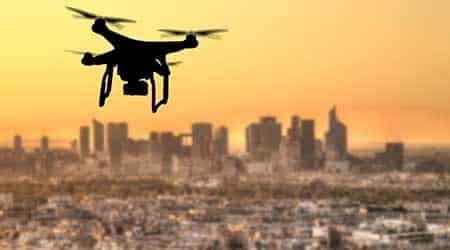What’s in today’s article?
- Why in News?
- Drones: Threat to Internal Security – Background, threat, challenges in tackling the threat, India’s anti-drone technology
- News Summary
Why in News?
- Most cases of violation of international border by drones originating from Pakistan in the past one year have taken place in the Amritsar sector of the Border Security Force (BSF).
- This was revealed by the data accessed by leading news paper from security agencies in India.
In Focus: Drones: Threat to Internal Security
Background:
- In June 2021, the Indian Air Force (IAF) base in Jammu was attacked using two low-intensity improvised explosive devices (IEDs).
- These IEDs were dropped from two drones.
- It was the first time that suspected Pakistan-based terrorists have used unmanned aerial vehicles in an attack.
- These attacks have restarted a debate around drones as a threat to internal security.
How are drones a threat to internal security?
- Transfer of weaponry to terrorists –
- Drones are capable to ferry arms and ammunition across the international border.
- In December 2019, the Punjab police unmasked a terror network that was using drones to ferry arms and ammunition across the international border from Pakistan.
- Attack on critical infrastructure
- In September 2019, the Saudi Arabia’s largest oil field was attacked using a swarm of drones.
- This highlights the capability of drone in carrying out pinpointed attack on critical infrastructure of a nation.
- Intelligence gathering
- Drones have proved its usefulness in intelligence gathering and surveillance.
- If we closely analyze the pattern of drone detection on Indo Pak borders, we can say that drones are widely being used to gather information.
- Supports Organized Crime
- The use of drones, especially by the drug cartels, is not a new modus operandi.
- Recently, the drone, recovered by the BSF from Fazilka’s (Punjab) bordering village, had two packets of heroin weighing around 1.6 kg.
- Challenge to anti-terror operations
- Police and security forces, trained in conventional methods to counter-terrorism, find themselves clueless when confronting unmanned aerial vehicles.
Why Tackling Drone is Challenging?
- Conventional radar systems fail to detect small flying objects. If these radars are calibrated to detect drones, these systems might confuse a bird for a drone.
- Currently, border forces in India largely use eyesight to spot drones and then shoot them down.
- Shooting these drones are very difficult as they fly at altitude difficult to target.
- Technology to disable their navigation, interfere with their radio frequency, or just fry their circuits using high energy beams have also been tested.
- None of these has, however, proven fool-proof.
India’s anti-drone technology
- India’s DRDO has made some investments in anti-drone technologies such as the ADITYA Directed Energy Weapon (DEW) and laser dazzles.
- The DRDO’s Counter-Drone System was deployed for VVIP protection at:
- the Republic Day parades in 2020 and 2021,
- former US President Donald Trump’s visit to Motera Stadium, Ahmedabad.
- Hyderabad-based technology R&D firm Grene Robotics has designed and developed India’s first indigenous drone defence dome called Indrajaal.
News Summary
- Punjab has witnessed a multi-fold increase in drone activities from across the international border with Pakistan.
- Security agencies are quite certain that these activities are aided and abetted by the Pakistan Rangers’ border outposts since most such unmanned aerial vehicles originate from near them.
Image Caption: Data on incoming UAVs from Pakistan
Q1) What is indrajaal defence system?
Indrajaal is India’s first indigenous drone defence dome. It has a capability to autonomously protect an area of 1000-2000 square kilometres against the aerial threats by assessing and acting on aerial threats.
Q2) Who is the father of drone?
Abraham Karem is regarded as the founding father of UAV (drone) technology
Last updated on June, 2025
→ UPSC Notification 2025 was released on 22nd January 2025.
→ UPSC Prelims Result 2025 is out now for the CSE held on 25 May 2025.
→ UPSC Prelims Question Paper 2025 and Unofficial Prelims Answer Key 2025 are available now.
→ UPSC Calendar 2026 is released on 15th May, 2025.
→ The UPSC Vacancy 2025 were released 1129, out of which 979 were for UPSC CSE and remaining 150 are for UPSC IFoS.
→ UPSC Mains 2025 will be conducted on 22nd August 2025.
→ UPSC Prelims 2026 will be conducted on 24th May, 2026 & UPSC Mains 2026 will be conducted on 21st August 2026.
→ The UPSC Selection Process is of 3 stages-Prelims, Mains and Interview.
→ UPSC Result 2024 is released with latest UPSC Marksheet 2024. Check Now!
→ UPSC Toppers List 2024 is released now. Shakti Dubey is UPSC AIR 1 2024 Topper.
→ Also check Best IAS Coaching in Delhi
























